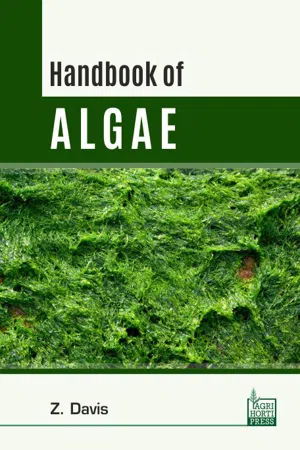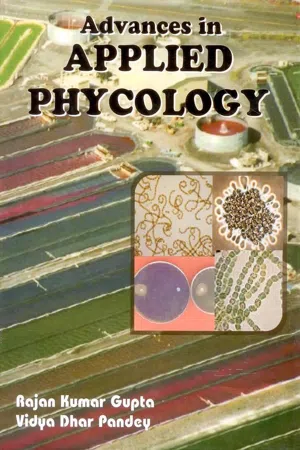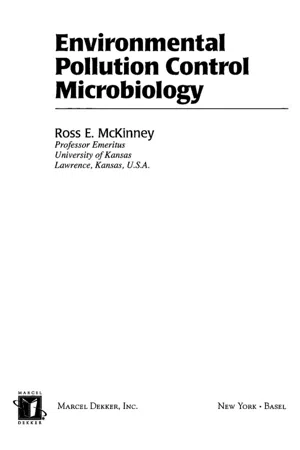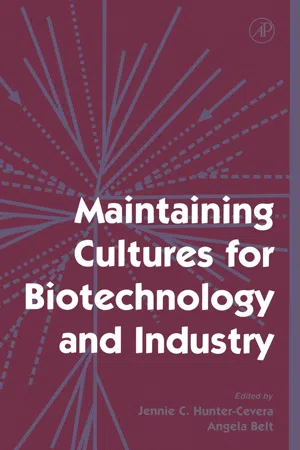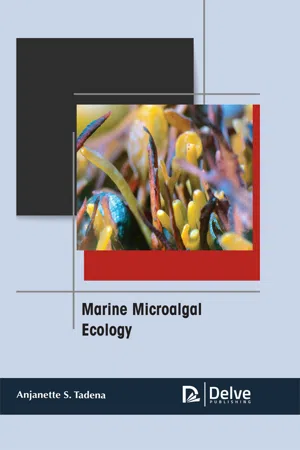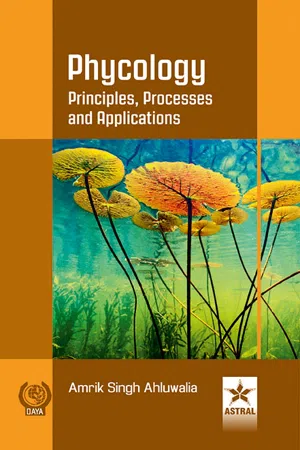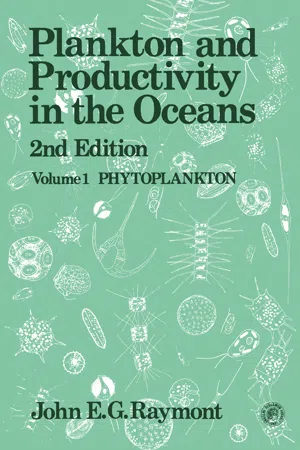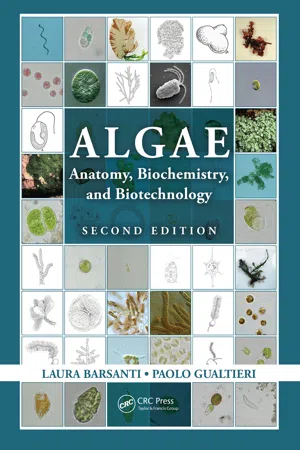Biological Sciences
Algae
Algae are a diverse group of photosynthetic organisms that can be found in various aquatic environments, including freshwater and marine habitats. They can range from single-celled microalgae to large, multicellular seaweeds. Algae play a crucial role in the ecosystem by producing oxygen and serving as a food source for various aquatic organisms.
Written by Perlego with AI-assistance
Related key terms
1 of 5
11 Key excerpts on "Algae"
- eBook - PDF
- Davis, Z(Authors)
- 2018(Publication Date)
- Agri Horti Press(Publisher)
Introduction 1 1 Introduction The word Algae represent a large group of different organisms from different phylogenetic groups, representing many taxonomic divisions. In general Algae can be referred to as plant-like organisms that are usually photosynthetic and aquatic, but do not have true roots, stems, leaves, vascular tissue and have simple reproductive structures. They are distributed worldwide in the sea, in freshwater and in wastewater. Most are microscopic, but some are quite large, some marine seaweeds that can exceed 50 m in length. The unicellular forms are known as microAlgae where as the multicellular forms comprise macroAlgae. Algae are very simple chlorophyll-containing organisms: some say that they are plants; other say that the are not, calling them protists or protoctists. We use the term “Algae” very loosely because defining them is very difficult. In general, we can say that they are simple organisms composed of one cell, or grouped together in colonies, or as organisms with many cells, sometimes collaborating together as simple tissues. Most Algae form some sort of spore, which is a cell that is often motile and serves to reproduce the organism. Some are colonial and motile in the adult phase like Volvox (right, photograph Karl Bruun). Algae also have sex, often a very simple kind of sex where the Algae themselves act as gametes, but sometimes very complicated with egg and sperm-like cells. This ebook is exclusively for this university only. Cannot be resold/distributed. 2 Handbook of Algae Some of the larger kelps have translocation but most do not. They have no need for water-conducting tissues as they are, at some stage, surrounded by water. They reproduce by spores of some kind. There are no seeds. Spores may be motile or non-motile; varies Karlphylum to phylum, e.g ., the red and blue-green Algae are non-flagellated. Algae of one kind or another have been around for more than 2 billion years. - eBook - PDF
Green Plants
Their Origin and Diversity
- Peter R. Bell, Alan R. Hemsley(Authors)
- 2000(Publication Date)
- Cambridge University Press(Publisher)
Biological features of Algae The simplest phototroph imaginable is a single cell floating in a liquid medium, synthesizing its own sugar, and reproducing at intervals by binary fission. Such organisms do in fact exist in both fresh and salt waters. Examples are provided by the cyanophyte Synechococcus (p. 28) and the minute marine Micromonas (Fig. 1.6). These organisms are examples of Algae, the group of plants showing the greatest diversity of any major division of the plant kingdom. They range from minute, free-floating, unicellular forms (represented by both prokaryotes and eukaryotes) to large plants, exclusively marine, several meters in length. Many of the smaller Algae form a component of plankton , the commu-nities of minute plants and animals which float at or near the surface of fresh waters and oceans. Algae are responsible for a large part of the photo-synthesis in the biosphere, the productivity of some coastal communities in the surf of warm seas exceeding that of the tropical rain forest. Much of the carbon so fixed enters the food chain of the aquatic heterotrophs. Despite the enormous range in size, the Algae remain comparatively simple in organization. In the smaller multicellular species (e.g., Merismopedia , Fig. 2.6; Pediastrum , Fig. 3.8) the cells resemble each other in appearance and function, and they can be regarded as forming little more than an aggregate of independent units. In the larger, however, there is morphological and cellu-lar differentiation, although usually less exten-sive than in most land plants. The few hetero-trophic forms, mostly small, are regarded as derived. Some, even the smallest (e.g., the dinoflagellates, p. 95), appear to be composite organisms, incorporating a photosynthesizing endosymbiont. Many Algae are fully immersed and firmly attached to the substratum. Together with a few vascular plants these constitute the benthos , and contrast with the floating plankton. - eBook - PDF
- Pandey, Vidya Dhar, Rajan Kumar Gupta(Authors)
- 2021(Publication Date)
- Daya Publishing House(Publisher)
They vary from small, single-celled forms to complex multicellular forms, such as the giant kelps of the eastern Pacific that grow to more than 60 meters in length and form dense marine forests. Algae are found in the fossil record dating back to approximately 3 billion years in the Precambrian”. They are the base organisms for the entire life on this planet earth, where water constitutes nearly 3/4 th of its surface i.e. , aquatic environments, which is dominated mainly by them. Algae being one of the important producers in aquatic environments play significant role in the structure and function of these ecosystems. They are the largest contributors of Gross Productivity on the planet. Recent reports have emphasized the potential use of selected heavy metal-sequestering Algae for the purpose of phytoremediation, environmental clean-up and restoration (Singh, 2004). Their trophic independence for Carbon and even Nitrogen ( e.g. , N 2 -fixing blue-green Algae) enables greater flexibility to them towards to adopting to altered/varied environmental conditions. In addition, their oxygenation and mineralization capabilities in the treatment systems points towards their potential use as the bioremediators of aquatic ecosystems. The Blue-green Algae The bluish appearing Algae were earlier recognized as Blue-green Algae (BGA), but later they were further recognized as ‘Cyanobacteria’ , owing to their resemblance with the prokaryotic nature conforming to that of bacteria. As they do not possess any flagella, they have developed a characteristic way of motion called gliding movement . Their photosynthetic pigments include the ‘ Biloprotein’ and ‘Carotenoids’ , which can trap sunlight in the wave length range the chlorophylls fail to do. N 2 in the stratosphere is nearly 3/4 th , which can be biologically fixed; and Carbon is also in abundance on this planet, which too can be fixed. Cyanobacteria are the simplest microorganisms which can carry out both at ease . - eBook - ePub
Environmental Pollution Control Microbiology
A Fifty-Year Perspective
- Ross E. McKinney(Author)
- 2004(Publication Date)
- CRC Press(Publisher)
Chapter 5Algae
Algae are photosynthetic microorganisms containing chlorophyll. They can be single cell or multicell, motile or non-motile. Algae use light as their source of energy for cell synthesis and inorganic ions as their source of chemicals for cell protoplasm. They are found where there is a reasonable amount of light and nutrient elements. Algae have both a positive and a negative impact on the environment. One of the positive aspects of Algae is the production of oxygen in proportion to the growth of new cells. On the negative side, Algae are responsible for tastes and odors in many surface water supplies. Algae also take stable inorganic ions and convert them into organic matter that ultimately must be stabilized. The new organic matter can be used as a source of nutrients for both plants and animals. Unfortunately, stabilization of dead Algae uses most of the oxygen produced during growth.DESCRIPTION
Like fungi, Algae are identified by their physical characteristics. The primary characteristic of Algae is pigmentation. Colors range from green to yellow-green to brown to red. Algae are larger than bacteria and can be easily seen and identified by microscopic examination at 100 X magnification. Like fungi, the Algae have a clearly defined nucleus and are classified as Eucarya. The filamentous Algae resemble fungi with photosynthesis providing the major difference between these two groups of microorganisms. Most of the filamentous Algae are larger than fungi. Some of the motile Algae resemble protozoa. The single cell, motile Algae look like green, flagellated protozoa. Current classification systems used to group microorganisms are arbitrary systems that do not delineate all the differences in the organisms. Transition organisms fall between two groups instead of being clearly defined by any one group. The lack of a defined nucleus caused a change in the classification of the blue-green microorganisms from Algae to bacteria. The Eighth Edition of Bergey’s Manual of Determinative Bacteriology classified the blue-green organisms as Cyanobacteria - Jennie C. Hunter-Cevera, Angela Belt(Authors)
- 1996(Publication Date)
- Academic Press(Publisher)
Algae Robert A. Andersen Background Introduction The Algae comprise an assemblage of plantlike organisms that are found in one prokaryotic and several eukaryotic evolutionary lineages. Physiologically, oxygen-evolving photosynthesis unifies the algal lineages, separating them from protozoa or fungi. Taxonomically, Algae are in an artificial group that defies precise definition; like other artificial groups, Algae are defined by the absence of characters rather than by their presence. For example, Algae can be considered plants that lack roots, stems, leaves, and embryos (Bold, 1973). Conversely, the individual monophyletic algal lineages possess distinctive photosynthetic pigments, storage products, and ultrastructural features (Bold and Wynne, 1985; Lee, 1989). Historically, the Algae have always included prokaryotic and eukaryotic forms (Smith, 1950), but recent studies have suggested that prokaryotic Algae are better classified as bacteria (i.e., cyanobacteria) (Stanier et al., 1971). Despite the shared prokaryotic nature of blue-green Algae and bacte- ria, blue-green Algae continue to be considered Algae by many others (e.g., Bold and Wynne, 1985; Lee, 1989). Less than 10 species of prokaryotic Algae have been described using the International Code of Nomenclature of Bacteria; all other species have been described following the Interna- tional Code of Botanical Nomenclature (Demoulin, personal communica- MAINTAINING CULTURESFOR BIOTECHNOLOGY AND INDUSTRY Copyright 91996 by Academic Press, Inc. All rights of reproduction in any form reserved. 29 30 Robert A. Andersen tion; Komarek, personal communication). In colleges and universities, the prokaryotic Algae are taught in phycology courses, not in bacteriology courses. And relevant to this chapter, prokaryotic Algae are maintained primarily in algal culture collections, not in bacterial culture collections (e.g., compare catalogs of strains; Gherna et al., 1989; Starr and Zeikus, 1993; Andersen et al., 1991).- eBook - PDF
- Anjanette S. Tadena(Author)
- 2019(Publication Date)
- Delve Publishing(Publisher)
This could result in a certain damage. It is smarter to incorporate one more class to suit those things which don’t promptly fall inside the scope of the recent advances. These rebels are to be found properly enough under the title of ‘Flotsam and Jetsam’ • Algae as beneficial organisms: for example, as a source of natural compounds, nourishment, chemicals; in soil colonization; and so on. • Algae as nuisance: for example, in water pollution; as a reason for poisoning; as parasites; and so forth. • Flotsam and Jetsam: for example, thermal Algae; Algae in art and drugs; and so on. Figure 3.1: Chlorella Vulgaris, a type of Algae is used in medicinal drugs. Source: https://c1.staticflickr.com/9/8609/28277921674_f26a8cd58f_b.jpg 3.2 BIOLOGICAL SIGNIFICANCE OF MARINE AL-GAE 3.2.1 Algae as Producers of Organic Matter Since Algae are autotrophs that make food for themselves, they share with the Biological and Commercial Importance of Marine Algae 71 other further developed, self-sustaining individuals from the plant kingdom the ability to blend complex natural particles out of carbon dioxide and water, utilizing different other major and minor components all the while. This procedure - the biochemical fulcrum of life on the planet - is called photosynthesis. On the endless execution of this procedure balances the progression of all creature life — which is completely subject to the plant world. Specifically, or at last, land creatures rely upon plants found on land for nourishment and sea creatures, in the same way, depend on Algae as their essential source of synthetically bound daylight and thus, energy. It is time to investigate the specific essential ramifications of this procedure called photosynthesis — the privilege exclusively of the plant kingdom. - eBook - PDF
- Anjanette S. Tadena(Author)
- 2020(Publication Date)
- Delve Publishing(Publisher)
These microbes play an important role to half of the global photosynthetic activity and in addition to this; these microbes are virtually found in euphotic niches (Andersen, 1996). According to the molecular biology literature, Algae are conceived as a bunch of microorganisms that have independently developed chloroplasts, that is, intracellular structures which are consisting of their own mechanism for the process of photosynthesis (Gibbs, 1992).Algae are categorized into over a dozen major groups. Mainly, the groups of Algae are based on pigment Introduction to Marine Algae 9 composition, storage profile of products, and diversity of ultrastructural features. All across the globe, there are several numbers of different species of planktonic Algae, or microAlgae, floating in the water. Green Algae, diatoms along with the dinoflagellates are the species that are most well-known among all, nevertheless; the other microalgal species are consisting of coccolithophores, cryptomonads, golden Algae, yellow-green Algae and euglenoid (Wetzel, 2001). Talking about Diatoms, they are single celled organisms drifting in the oceans, and they account for production of near about half of Earth’s oxygen with the help of their photosynthetic processes. Red and brown Algae are not conceived in the form of phytoplankton, and the reason behind this is that they are not free-floating. True red and brown Algae are hardly ever single-celled, and they remain linked to the rock or the other structures in spite of drifting at the surface of the water. In addition to this, there are some species of green Algae that are found as multicellular, are also not conceived in the form of phytoplankton for the same reasons. - Ahluwalia, Amrik Singh(Authors)
- 2021(Publication Date)
- Daya Publishing House(Publisher)
Introduction Algae comprises multitude of heterogenous and polyphyletic assemblage; ranging from minute unicells to gigantic kelps. These ubiquitous organisms are found on rocks, soil, trees as well as predominant in water bodies, both marine and fresh water of tropical, temperate and polar regions (Ahluwalia, 1993). Culture of aquatic organisms for their commercialization is known as aquaculture. Sustainable aquaculture includes the judicious use of This ebook is exclusively for this university only. Cannot be resold/distributed. the resources (i.e. Algae, fishes etc.) thus ensuring their availability for the present generation as well as preserved for the future. With increasing population, there is an acute pressure on land for the available resources and hence their over exploitation and even depletion. In this context, aquatic resources are being explored as an alternative to sustain the ever increasing number of human race for food. The importance of Algae in aquaculture has been well known since ages. The organisms constitute the basic link of the food cycle of aquatic animals (DeSilva and Anderson, 1995). Without a proper appreciation of the role of these autotrophic organisms (Algae), the sustained maximum yield of fish cannot be obtained or maintained (Reitan et. al., 1997). Since total global aquacultural production has been rising every year, this industry is projected to grow at the rate of 8% per year for foreseeable future (Tacon, 1998) and hence the importance of Algae. Decreasing natural catches and increasing world dependence on the fish as a food source has led to a growing interest in aquaculture. Central to sustainable aquaculture is the need to establish and maintain a food chain to support the animals until they achieve the market size. The annual global aquacultural production of marine Algae is currently placed around 6.5 x 10 6 tonnes (Tacon, 1998).- eBook - PDF
Our Energy Future
Introduction to Renewable Energy and Biofuels
- Carla S. Jones, Stephen P. Mayfield(Authors)
- 2016(Publication Date)
- University of California Press(Publisher)
This evolutionary history lasting hundreds of millions of years further suggests their poten-tial for unique adaptive traits required during the transition between different planetary environments over this time period (Sorrels, 2009). Throughout the remainder of this book, we will refer to cyanobacteria, diatoms, true micro-scopic Algae, and macroAlgae collectively as Algae; however, it is important to realize that each of these types of Algae represents very distinct organisms that offer different traits and characteristics useful in the production of a wide vari-ety of different types of biofuels including gases, liquids, and solids. Moreover, these Algae have a wide array of unique genetic properties that can be more easily and quickly studied for biotechnological applications than many similar properties found in more complex land plants. While corn, spinach, or strawberries might seem more familiar when it comes to plants important for fueling human metabolism, Algae are also not uncommon within our everyday lives. For instance, sushi is a fairly common food consumed by people around the world. In many cases, a sushi roll is wrapped in seaweed, a type of macroAlgae. Another example of an algal species used in food products can be found in the Naked Brand smoothie known as the “Green Machine.” While this smoothie contains conven-tional fruits and vegetables like apples, bananas, spinach, and ginger, it also includes both cyanobacteria and true microAlgae (Naked Juice Company, 2012). The use of Algae is not limited to food products; some hair and cosmetic products use Algae within their formulas due to the natural concentration of antioxidants. While Algae provide a host of beneficial nutrients, they also offer a suite of metabolic processes that can be leveraged in medicinal and biotech-nological applications. - eBook - PDF
Plankton & Productivity in the Oceans
Volume 1: Phytoplankton
- J. E. G. Raymont(Author)
- 2014(Publication Date)
- Pergamon(Publisher)
Chapter 4 The Algae of the Phytoplankton A Review of the Major Classes Although in shallow waters a restricted number of genera of flowering plants contribute very significantly to primary production (cf. Chapter 3), the Algae are generally dominant in the marine environment. In shallow waters both benthic and planktonic Algae are significant, but over deeper waters and throughout the open oceans only the phytoplankton contributes, apart from the drifting masses of Sargassum weed which occur in some areas of the ocean. Among the Algae, both benthic and planktonic, the variety is considerable. This great group of plant organisms includes the macroscopic seaweeds, as well as unicellular forms and very small colonies of varied shape. The phytoplankton is composed of single cells or of relatively simply organized, small colonies, but a considerable diversity of algal groups is represented. One particular type of colony is found in nearly all these groups: numbers of non-motile cells are embedded in a mucilaginous matrix (the palmelloid stage). Where thalloid, filamentous or palmelloid forms constitute the dominant stage in the life history, a considerable contribution to the marine phytoplankton may come from the production of flagellated zoospores or non-motile aplanospores. Certain algal groups (Cyanophyceae and Rhodophyceae), however, never produce motile stages. Detailed morphological characteristics are not easy to describe accurately in such small organisms as phytoplankton, but more recent electron-microscope studies, elucidating fine structure of such cell constituents as scales, cell wall (cf. Dodge, 1973), flagella, etc., have contributed to specifying group features. Biochemical characters including photosynthetic pigments, especially the variety of xanthophylls (cf. Naka-jama, 1962), and storage products, also show a remarkable diversity throughout the Algae. - eBook - PDF
Algae
Anatomy, Biochemistry, and Biotechnology, Second Edition
- Laura Barsanti, Paolo Gualtieri(Authors)
- 2014(Publication Date)
- CRC Press(Publisher)
In particular, Algae are important for the biogeochemical cycling of the chemi-cal elements they uptake, assimilate, and produce such as carbon, oxygen, nitrogen, phosphorus, silicon, and sulfur. We will now briefly consider some of the aspects of these elements in relation to biosynthesis and photosynthesis. LIMITING NUTRIENTS Among the elements required for algal growth, there are some that can become limiting factors. The original notion of limitation was introduced by von Liebig more than a century ago to establish a correlation between the yield of a crop and the elemental composition of the substrate required for the synthesis of that crop. Von Liebig stated that if one crop nutrient is missing or deficient, plant growth will be poor, even if the other elements are abundant. That nutrient will be defined “limiting nutrient.” This concept has become to be known as Liebig’s “Law of the Minimum.” Simply stated, Liebig’s law means that growth is controlled not by the total of nutrients available but by the nutri-ent available in the smallest quantity with respect to the requirements of the plant. Liebig likens the potential of a crop to a barrel with staves of unequal length. The capacity of this barrel is limited by the length of the shortest stave and can only be increased by lengthening that stave. When that stave is lengthened, another one becomes the limiting factor. The concentration of a nutrient will give some indication whether or not the nutrient is a limiting factor, but the nutrient’s supply rate or turnover time is more important in determining the magni-tude or degree of limitation. For example, if the concentration of a nutrient is a limiting factor, but the supply rate is slightly less than the uptake rate by the Algae, then the Algae will only be slightly nutrient-limited. Not all the Algae are limited by the same nutrient, but it occurs at the species level, 201 Biogeochemical Role of Algae for example, all the diatoms are limited by silicate.
Index pages curate the most relevant extracts from our library of academic textbooks. They’ve been created using an in-house natural language model (NLM), each adding context and meaning to key research topics.
